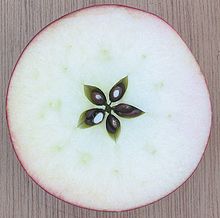Pome
![]()
This article or subsequent section is not sufficiently supported by evidence (e.g., anecdotal evidence). Information without sufficient evidence may be removed in the near future. Please help Wikipedia by researching the information and adding good supporting evidence.
Note text
In plant morphology, an apple fruit is understood to be bellows or aggregate bellows fruits surrounded by axial tissue, i.e. pseudo-fruits.
In this case, originally opening at the ventral suture (inwards), bellows fruits are already sunken into the flower base at the time of flowering (inferior ovary). The flower axis then grows into a fleshy tissue when the fruit ripens. In the inner part of the apple fruit, a parchment-like to bony (stone apple, nut apple) core (endocarp) develops from the bellows-like fruit leaves. The outer flesh of the fruit itself contains at most isolated stone cell nests.
Apple fruits are typical of the Rosaceae sub-tribe of the pome fruit family (Pyrinae). Well-known examples are the eponymous apple, the pear, the quince and the medlar, but also the rowan and the wood sorrel belong to it (pome fruit).
Similarly, the fruit of the rose, the rosehip, is a gleaning nut fruit with free nutlets (achenes) that are more or less surrounded by fleshy axial tissue.

Apple fruit

Apple fruit of cultivated apple (Malus domestica) in cross-section
Search within the encyclopedia